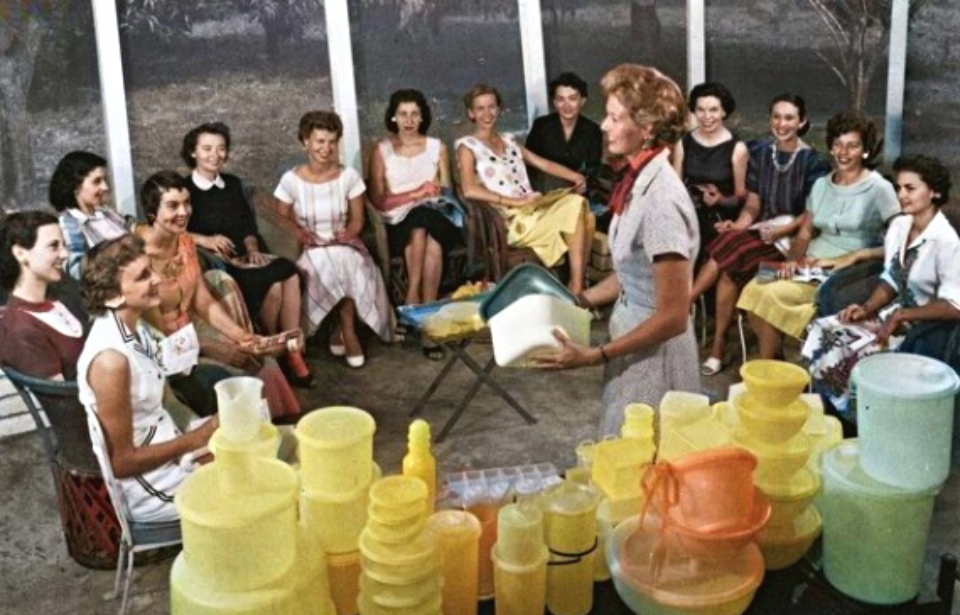Tupperware Home Parties were a staple of suburban postwar America. Held by the same housewives the products were marketed toward, these events offered women a chance to start their own businesses in a country that otherwise wanted them to stay home. Since Tupperware’s creation, the company has thrived. However, as times have changed, it’s been struggling to survive.
Earl Silas Tupper created a product no one wanted
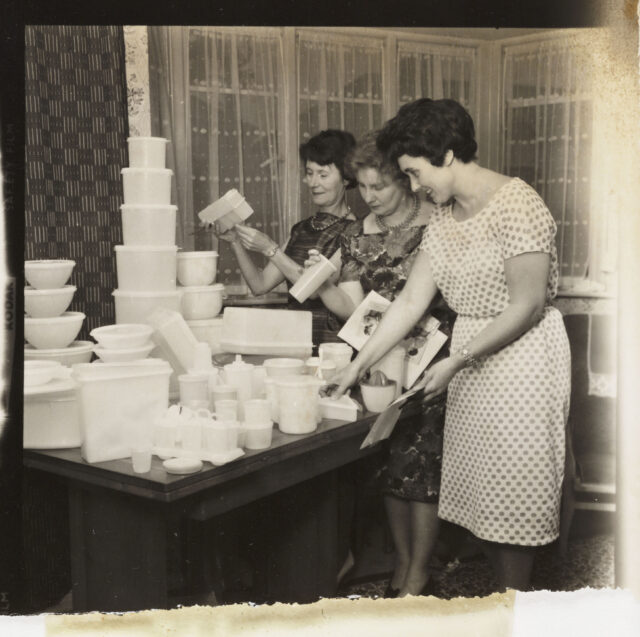
In the 1940s, Earl Silas Tupper invented a refined and improved version of polyethylene, an industrial byproduct, and called it “Poly-T.” He used the material to create a new line of kitchenware that was very different from the kinds found in middle-class homes in the early 1940s.
Tupper first introduced his products, called “Tupperware,” to consumers via department stores and catalogues. The material’s oily feel and seemingly cheap construction, however, turned many away from purchasing it. Additionally, many didn’t know how to properly use the airtight lids, which needed to be “burped” to properly seal.
As such, those who did purchase Tupperware often returned the containers to the store, thinking they were defective. By the end of the decade, Tupper’s business was doing poorly. He needed to come up with a new approach to sell his products or else it would continue to suffer.
A new way to sell Tupperware
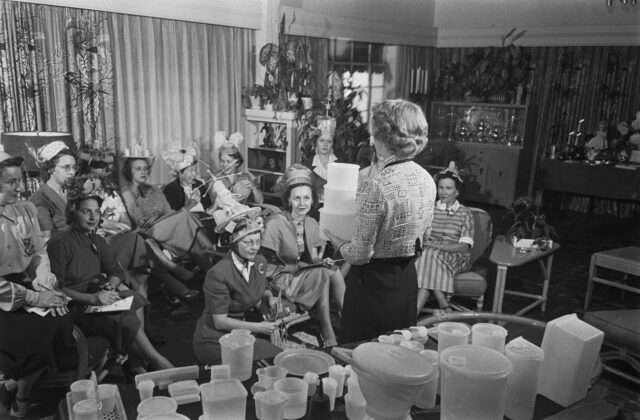
While Tupper was establishing Poly-T as a consumer product, another company called Stanley Home was rolling out a new sales approach – the “home party.” This saw the company’s salespeople selling directly to consumers from the comfort of their homes. No longer were salesmen stopped at the door – now, they were welcomed in to pitch their product to multiple consumers at once, as these parties typically included friends.
One of Stanley Home’s employees, Brownie Wise, was a low-income, divorced single mother living in Detroit who borrowed the home party concept and applied it to selling other products. She started selling Tupperware through her own business, “Patio Parties,” and saw great success. She even began to recruit other housewives, training them to become their own Tupperware saleswomen.
Tupper was impressed by Wise’s sales and reached out to learn how she was able to generate such high numbers. She explained that it was the Tupperware Home Parties she held. Her success was all he needed to see and, in 1951, Tupper pulled his products from shelves and the pages of catalogues. Thanks to Wise, he was ready to fully invest in direct-to-consumer sales.
That same year, Tupper hired Wise as Tupperware’s general sales manager and vice president. Given the social dynamics of the time, historian Alison J. Clarke explained how “Tupper’s decision to invest wholeheartedly in amateur businesspeople and an informal, peripheral sales activity was either an act of inspired entrepreneurial vision or a reflection of his desperation.”
Brownie Wise’s sales approach transformed the business
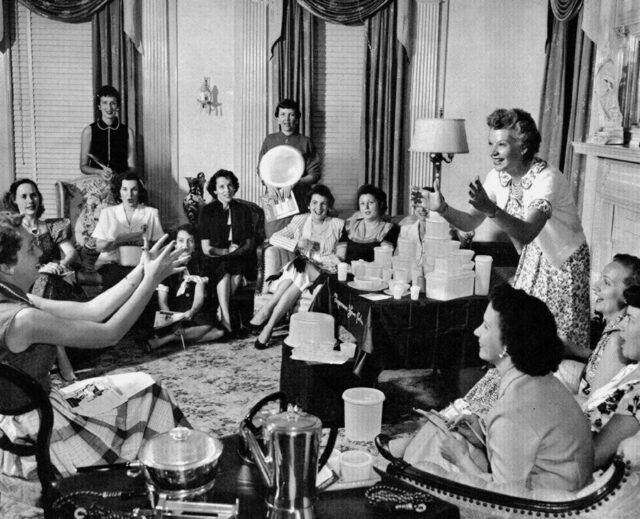
A key part of Wise’s sales approach was she knew how to properly demonstrate how to use Tupperware at her parties. She’d make her demonstrations fun and exciting by throwing products across the room to prove they wouldn’t break and by having everyone play educational party games. Wise believed that, “if we build the people, they’ll build the business.”
Tupperware Home Parties (THPs) were so fun that other housewives were eager to join and begin selling Tupperware themselves. The housewife thus became both the perfect salesperson and consumer.
THPs really took off following the end of the Second World War because when husbands returned from the conflict, the women who’d filled their spots in the workforce were pushed back into their suburban homes. These parties gave them the opportunity to earn an income while also fulfilling their housewifely duties. They could provide a service while also selling women products that encouraged their place within the home.
As such, THPs quickly became a trademark of postwar America, emboldening women and allowing them to break away from gender norms. To further encourage these saleswomen, Wise and the company hosted an annual Homecoming Jubilee, which brought all of the company’s employees together. Here, top sellers would be rewarded for their efforts, receiving extravagant gifts that included diamonds rings and designer clothes.
Brownie Wise was cut out from the Tupperware business

Tupper and Wise were very different people. Even though they were both inventive individuals, they had different preferences to conducting business. Tupper didn’t like attending the Homecoming Jubilees, as he hated large gatherings. Wise, on the other hand, loved to put on the celebrations and be at the heart of it all with her charisma and enthusiasm.
Wise became a face for the company, appearing as the first woman to be featured on the cover of Business Week in 1954. She also featured in several other publications across the United States. She was the success story all Tupperware saleswomen strived for – transitioning from an enterprising housewife to one of the leaders of a widely successful business.
As the Tupperware business was heating up and growing in popularity, the relationship between Tupper and Wise turned sour. In 1958, a conflict between the two resulted in Wise being fired from the business. The spat must have been bad because, despite everything she did for the company, Tupper removed her from virtually every piece of corporate literature. Additionally, upon her dismissal, she received no stock in the company.
It wasn’t long after Wise’s departure from Tupperware that Tupper sold the business to the Rexall Drug Company for $16 million.
Tupperware is struggling to survive
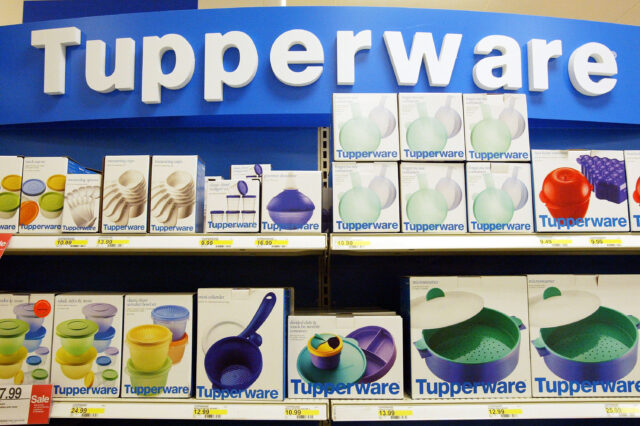
Even with its sale to another company, Tupperware was a thriving business for decades. However, it’s recently gone through some hard times. Some believe the company’s been unable to market to newer generations, which has been detrimental to sales.
“The company used to be a hotbed of innovation with problem-solving kitchen gadgets, but it has really lost its edge,” Neil Saunders, retail analyst and managing director at GlobalData Retail, told CNN.
In 2022, the company reported its sales force had fell a whopping 18 percent, while its stock had fallen 98 percent between April 2022 and April 2023. These may have been factors in its decision not to file an annual report. However, without one, the New York Stock Exchange has warned that its stock could be de-listed sometime soon.
More from us: Did Marilyn Monroe Have a Secret Husband?
The company released a statement, saying there’s “substantial doubt about the company’s ability to continue” and it’s working with financial advisors to try and keep the business afloat. President and CEO Miguel Fernandez said, “The company is doing everything in its power to mitigate the impacts of recent events, and we are taking immediate action to seek additional financing and address our financial position.”
